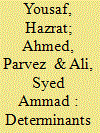| Srl | Item |
| 1 |
ID:
175352


|
|
|
|
|
| Summary/Abstract |
Per capita availability of water is a serious challenge for Pakistan, like other countries. The objectives of this study are to investigate the different sources of water supply use by Pakistan’s urban households, their willingness to pay and modelling the determinants of the households’ budget allocation for water consumption. The study employed Pakistan Social and Living Standards Measurement (PSLM) 2015–2016 data set, which revealed that more than 60 per cent of households rely on piped water. The result of the variable filtration plant shows that urban households take less care of their health because the tendency of filtered water use is low. The regression result shows negative effect of per capita income, and positive effect of square of per capita income reflects that measures to accelerate income will help to increase budget allocation for water supply at the households’ level. The findings call for accelerating the water filtration plants, water availability in tap and higher incomes while controlling the population size and shared common washroom can help to save water in the case of urban Pakistan.
|
|
|
|
|
|
|
|
|
|
|
|
|
|
|
|
| 2 |
ID:
143530


|
|
|
|
|
| Summary/Abstract |
This study analyzes the household food demand followed by projecting the future level of demand of selected food commodity groups in Pakistan. It uses Pakistan Panel Household Survey (PPHS) for the year 2010, conducted by Pakistan Institute of Development Economics (PIDE). The linear approximation/almost ideal demand system (LA/AIDS) model is used to estimate the demand elasticities, while a simple growth model is used for food demand projections. The empirical results reveal that food grains, pulses, ghee, sugar and vegetables are necessities, while milk and meat are luxuries. Pulses and vegetables, ghee and meat, milk and sugar are identified as gross complements on the basis of uncompensated cross-price elasticities. The uncompensated cross-price elasticities of food grains indicate the substitutive relationship between different food items, such as pulses, meat and vegetables. An increase in the household income will induce a substantial expansion in household demand for milk and meat products, but the consumption of these foods will decline if household size grew, ceteris paribus.
|
|
|
|
|
|
|
|
|
|
|
|
|
|
|
|